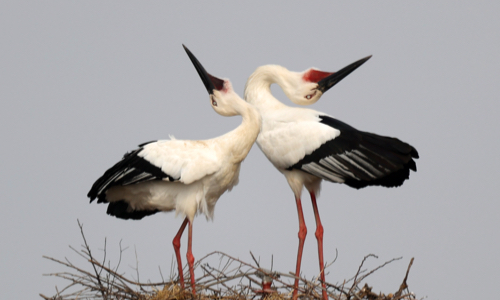ARTS / CULTURE & LEISURE
China’s nature reserve in Heilongjiang Province creates wetlands home for Oriental storks

A pair of Oriental storks Photo: IC
Editor's Note:With China as the country of presidency, the second phase of the 15th meeting of the Conference of the Parties to the UN Convention on Biological Diversity (COP15) is now being held in Montreal, Canada in December.
This series will show the various animals and plants in China that thrive as a result of the country's efforts in biodiversity conservation and building up sustainability.
The Honghe National Nature Reserve in Northeast China's Heilongjiang Province is known as the home of the endangered Oriental stork. Thanks to strengthened protection efforts, including favorable policies and the use of scientific methods, the population of these precious big birds has increased in recent years.
The reserve located on the Sanjiang Plain covers an area of 21,835 hectares.
It became a national nature reserve in 1996, and was included in the "List of Wetlands of International Importance" in 2002.
The main protection focus of the reserve is the wetlands ecosystem composed of aquatic and terrestrial organisms and their environment, including Oriental storks, red-crowned cranes, white-naped cranes, whooper swans, golden eagles, white-tailed eagles and other rare and endangered wild animals.
The reserve protects the swamp landscape of the Sanjiang Plain in China. It is the most complete and best-preserved natural wetlands in the country. The biodiversity in the region is extremely rich, making it a vital area for protection efforts.
In the early 1990s, there were only two to three breeding pairs of Oriental storks in the Honghe National Nature Reserve on the Sanjiang Plain. From 1993 to 2022, a total of 389 artificial nests were built in the reserve, attracting a total of 741 pairs of Oriental storks to successfully breed there. In total, the population of birds has increased by 2,193.
Over the last 29 years, employees at the reserve have been exploring more reasonable and proper ways to help the Oriental storks.
Nearly a quarter of the world's Oriental storks were born in Honghe. It has been recognized by international experts as the most concentrated artificial breeding area for Oriental storks in the world.
Despite protecting the natural swamps on the Sanjiang Plain and effectively attracting Oriental storks to nest here, the Honghe National Nature Reserve has also been passing its experience to nearby protection zones through training programs.
Technology, such as the artificial nests and satellite tracking, have also been used in other provinces of China, as well as some regions in Russia, including Amur Oblast, Khabarovsk Krai, the Jewish Autonomous Oblast and Primorsky Krai.
These efforts have significantly increased the breeding population of Oriental storks, while also greatly benefiting the investigation and monitoring capabilities of scientific researchers, as well as satellite tracking and research capabilities.




